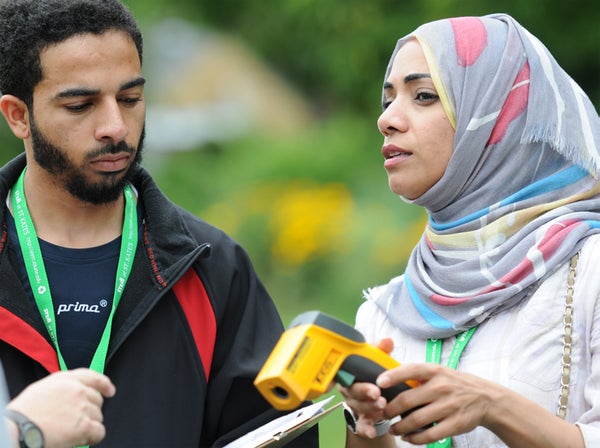This article was published in Scientific American’s former blog network and reflects the views of the author, not necessarily those of Scientific American
The GLOBE Program (Global Learning and Observations to Benefit the Environment) has spent the last 20 years making the case for K-12 students as citizen scientists. In fact, it has made the case millions of times – with more than 10 million students collecting more than 140 million data points around the world. Their measurements have ranged from soil moisture to surface temperature to cloud observations and have provided data for numerous academic publications about the global environment.
Rather than creating stand-alone experiments or kits for classrooms, GLOBE involves students through collaborative, global campaigns. These campaigns are proposed by scientists and have specific training materials to ensure that data collected by a fourth grader in Milwaukee can be added to the equivalent data taken by a tenth grader in Prague. Contributing to global datasets not only gives students a chance to collect data that scientists can actually use, but allows them to compare their experiences and findings with other students around the world.
Tony Murphy, Director of the GLOBE Implementation Office, said that the campaigns give students a chance to learn about their local environment and see how it fits into a broader global context. While the method to measure soil moisture may be the same, students measuring in an area with abundant farming will see it in a different context than those in an urban setting or in an area plagued by persistent drought. Director Murphy explained that it is a chance for students to see that science happens in a context, both environmental and cultural.
On supporting science journalism
If you're enjoying this article, consider supporting our award-winning journalism by subscribing. By purchasing a subscription you are helping to ensure the future of impactful stories about the discoveries and ideas shaping our world today.
One campaign now in its sixth year originated in a few Ohio classrooms, but it has since expanded to involve schools across multiple continents. Every December Dr. Kevin Czajkowski from the University of Toledo tasks students with collecting surface temperatures in their hometowns. Students carefully use the methods described in the campaign to collect their data. The work of these students has yielded a dataset that spans not only geographic boundaries, but also years. At the end of January, Dr. Czajkowski writes a report that analyzes the data for the schools to share with the students who participated. Any class that learns how to use these measurement techniques can be a part of this global initiative.
Another campaign compares soil moisture measurements on the ground with those taken via satellite. Students are even provided with a way to calculate the time when the satellite will pass overhead, letting them take measurements with their hands at the same time as other measurements are being made from space. One South American campaign is measuring changes in ground cover during El Niño events.
From proposing campaigns and designing training materials to collaborating with teachers and meeting with students, GLOBE depends on involvement from throughout the scientific community for its success. The GLOBE website contains resources and suggestions, encouraging as many scientists as possible to engage in outreach.
For interested students who want to participate more independently, or take their citizen science with them, GLOBE has created an App for observing clouds and noting mosquito populations. Recently GLOBE has even added students and teachers to the attendees of their annual meeting, bringing together the full spectrum of program participants for discussions.
Director Murphy said that while the program is doing its best to encourage participation in outreach, GLOBE is first and foremost a K-12 citizen science program. He sees no reason that someone should have to wait until they are 18 to become a citizen scientist. GLOBE has shown a number of reasons not to wait … millions of reasons and counting.
To find out more, check out www.GLOBE.gov
Some examples of research that has made use of GLOBE datasets include:
Cinnamon, J., (2015) "Deconstructing the binaries of spatial data production: Towards hybridity." The Canadian Geographer, 59(1):35-51. (link)
Kroen, W., (2015) "Using Authentic Environmental Data to Enhance Biology Understanding," The American Biology Teacher, Vol. 77 No. 9. (link)
Lor, Mai See. (2015) "Surface Temperature Between Short-Grass, Asphalt, and Dirt: A Study on the Effects of Albedo." Ohio Journal of Science. (link)
Rice, S., Ross, S., (2015) "Oklahoma Deciduous Trees Differ in Chilling Enhancements of Budburst." Oklahoma Native Plant Record. (link)
Consuelo Perez, M., Rodriguez Leon, I., & Rodriguez Navar, E. N. (2012, July). Absortion and scattering of aerosols related with its effects over the population's respiratory system in the Guadalajara Metropolitan Area (GMA). In Geoscience and Remote Sensing Symposium (IGARSS), 2012 IEEE International (pp. 2540-2543). IEEE. (link)
Czaczyk, Z. (2012). Evaluation of the existing meteorological stations for the agrometeorological protection of agriculture in Wielkopolska. (link)
